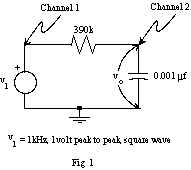EE 212 Lab
Lab 3: Square Waves and RC Time Constants
Prelab 3
The purpose of this lab is to measure the step and square-wave responses
of an RC circuit to gain a better understanding of step responses and time
constants.
Laboratory Procedure:
1. Observe waveforms using the oscilloscope and note effects of AC vs. DC
coupling.
-
Set the frequency of your function generator to approximately 10 Hz and the
waveform to a 5V peak-to-peak square-wave and then a 5V peak-to-peak
triangle-wave. Set up the oscilloscope to view these waveforms.
-
Note and sketch differences when the scope input is AC or DC coupled. Explain
why the signal is degraded on AC coupling? Use DC coupling for the rest of
this lab.
2. Measure rise time of a function generator square-wave.
-
Set the frequency of a 5V peak-to-peak square-wave to 1MHz on the function
generator and measure the rise-time of the square-wave (i.e., the time it
takes to go from 10% to 90% of its final value while rising) using the
oscilloscope by expanding the time base.
3. Calibration and probe settings for the oscilloscope.
-
Display the 1kHz square-wave from the probe comp output of your scope.
Adjust the trigger to obtain a stable waveform if necessary.
-
Measure the amplitude of the waveform with the 10X probe in both the
1X and 10X positions.
-
Compensate the probe in the 10X position to correctly view
the square wave. Draw the wave shape when the probe is under-compensated
and over-compensated.
-
Why does one use a 10X probe? (There are at least 3 possible reasons.)
4. View and investigate RC circuit step responses.
-
Construct the RC circuit shown in figure 1 on your breadboard using your
function generator to generate the 1kHz, 1V peak-to-peak square-wave input
v1. Display both the input v1 and output vo
on the scope using Channels 1 and 2. Trigger on the rising edge of the input.

-
Sketch the output waveforms of a single period for signal input periods of:
T = 10t, t, and
0.1t. Label your axes. Explain the form of these
plots and compare to your theoretical waveforms done in the prelab.
For which pulse length does the output most resemble the input.
-
For the input period T = 10t, the initial part
of the waveform is equivalent to the step response of the circuit.
Use the relationship obtained in the prelab to determine the time constant
of this circuit by measuring the 10% to 90% rise time. Compare with the
theoretical time constant.
-
Repeat the previous two parts with the resistor and capacitor interchanged.
Note this circuit setup can be thought of as similar to the AC coupling studied
in part 1. Sketch the circuit, sketch the input and output waveforms as the
input period is varied, and answer the following questions:
-
For which pulse length does the output most resemble the input?
-
Why does the range of the output waveform exceed the voltage range of the
source?
-
Why isn't the output amplitude constant?
© Copyright 2003 New Mexico Institute of Mining and Technology

